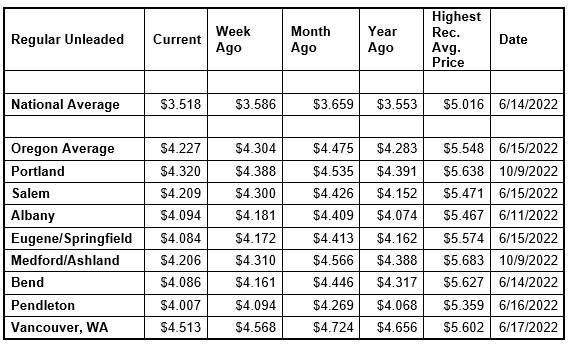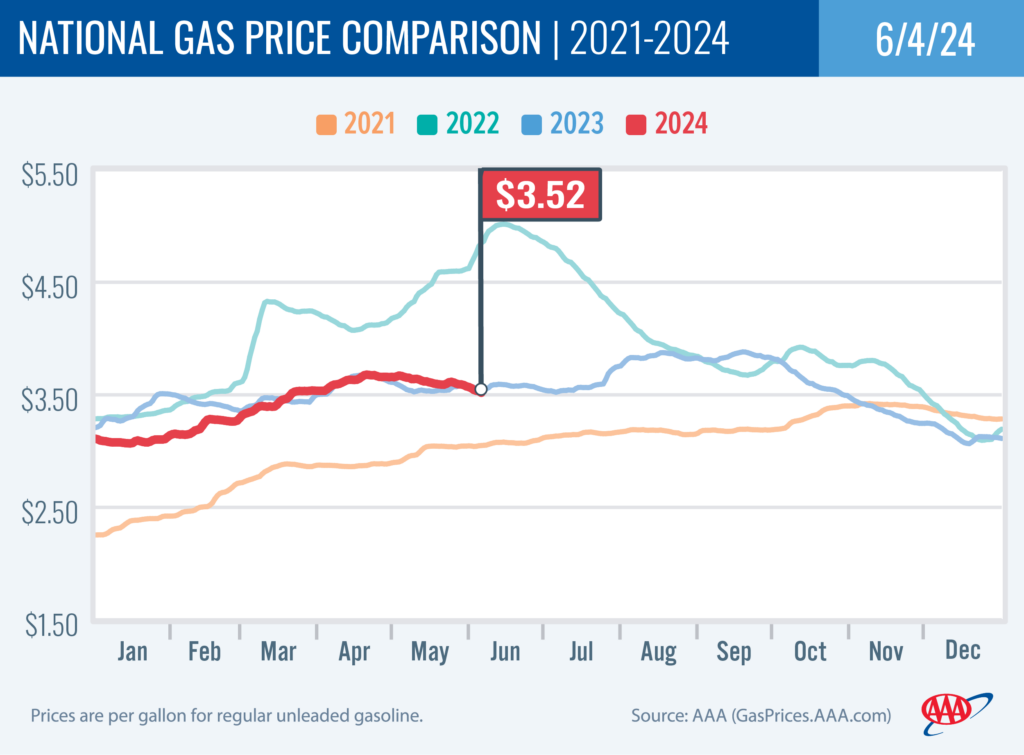PORTLAND, Ore., – The national and Oregon averages for a gallon of regular gas have fallen to their lowest prices since March. The driving factors are lower crude oil prices, tepid demand for gas, and increasing gasoline supplies. But June 1 marked the start of the Atlantic hurricane season and forecasters predict it will be an active one. Any storm that impacts oil production and refining in the Gulf Coast has the potential to send pump prices higher. For the week, the national average for regular falls seven cents to $3.52. The Oregon average loses eight cents to $4.23 a gallon.

“Gas prices will likely continue to edge lower now that we’re between the Memorial Day and Independence Day holidays, barring unforeseen events. With two major ongoing geo-political events, the wars between Russia and Ukraine, and Israel and Hamas, crude oil prices could rise again. And we’re on weather watch – hurricanes and extreme heat have the potential to impact refinery output,” says Marie Dodds, public affairs director for AAA Oregon/Idaho.
The Oregon average began 2024 at $3.79 a gallon compared to $4.23 today. Its lowest price so far this year is $3.58 on February 14 and the highest is nearly $4.51 on May 1. The national average started the year at $3.11 and is at $3.52 today. Its lowest price so far this year is just under $3.07 on January 15 and the highest is just under $3.68 on April 19.
Gas prices always rise starting in late winter through the spring as refineries undergo maintenance as the switch to summer-blend fuel occurs. The switch occurs first in California, which is why pump prices on the West Coast often rise before other parts of the country. The East Coast is the last major market to make the change to summer-blend fuel. Most areas have a May 1 compliance date for refiners and terminals, while most gas stations have a June 1 deadline to switch to selling summer-blend until June 1. Switch-over dates are earlier in California with some areas in the state requiring summer-blend fuel by April 1. Some refineries will begin maintenance and the switchover as early as February.
Crude oil prices have remained volatile due to geopolitical events around the world including the war between Israel and Hamas, the war between Russia and Ukraine, and Houthi militant attacks in the Red Sea. In addition, production cuts by OPEC+ have tightened global crude oil supplies. OPEC+ met on June 2 and, as expected, the cartel will extend production cuts into the third quarter. This has sent crude prices slightly higher this week.
The price of crude oil reached the year-to-date high of nearly $87 per barrel on April 5 and has moved lower since then. West Texas Intermediate climbed above $80 on March 14 and above $85 on April 2, then dipped below $85 starting on April 17 and below $80 again on May 1. Major drivers of elevated crude prices are the unrest in the Middle East and the Ukrainian attacks on Russian refineries. Russia is a top global oil producer and the refinery attacks have reduced output.
Crude prices have been volatile after the attack on Israel by Hamas in October. While Israel and the Palestinian territory are not oil producers, concerns remain that the conflict could spread in the Middle East, which could potentially impact crude production in other oil-producing nations in the region.
Crude oil is trading around $73 today compared to $79 a week ago and $72 a year ago. In 2023, West Texas Intermediate ranged between $63 and $95 per barrel. Crude reached recent highs of $123.70 on March 8, 2022, shortly after the Russian invasion of Ukraine, and $122.11 per barrel on June 8, 2022. The all-time high for WTI crude oil is $147.27 in July 2008.
Crude oil is the main ingredient in gasoline and diesel, so pump prices are impacted by crude prices on the global markets. On average, about 56% of what we pay for in a gallon of gasoline is for the price of crude oil, 19% is refining, 10% distribution and marketing, and 15% are taxes, according to the U.S. Energy Information Administration.
Demand for gasoline in the U.S. fell slightly from 9.31 million b/d to 9.14 million b/d for the week ending May 24, according to the U.S. Energy Information Administration (EIA). This compares to 9.10 million b/d a year ago. Meanwhile, total domestic gasoline stocks rose from 226.8 to 228.8 million bbl.
Lower gasoline demand, increasing supply, and falling oil costs could lead to pump price decreases.
Quick stats
Oregon is one of 46 states and the District of Columbia with lower prices now than a week ago. Indiana (-18 cents) has the biggest weekly drop in the nation. Colorado (+4 cents) has the largest week-over-week increase. Oregon has the 11th-largest weekly decline.
California ($5.03) has the most expensive gas in the nation for the 14th week in a row and remains the only state in the nation with an average at or above $5 per gallon. Hawaii ($4.76) is second, Washington ($4.49) is third, Oregon ($4.23) is fourth, Nevada ($4.21) is fifth, Alaska ($4.16) is sixth. These are the six states with averages at or above $4 a gallon, down from seven states a week ago. This week 44 states and the District of Columbia have averages in the $3-range. No states have averages in the $2 range this week.
The cheapest gas in the nation is in Mississippi ($3.01) and Arkansas ($3.02) and. No state has had an average below $2 a gallon since January 7, 2021, when Mississippi and Texas were below that threshold.
The difference between the most expensive and least expensive states is $2.02 this week, compared to $2.08 a week ago.
Oregon is one of 49 states and the District of Columbia with lower prices now than a month ago. The national average is 14 cents less and the Oregon average is 25 cents less than a month ago. This is the fifth-largest month-over-month decline in the nation. Nevada (-34 cents) has the largest monthly drop. Colorado (+7 cents) is the only state with a month-over-month increase.
Oregon is one of 36 states with lower prices now than a year ago. The national average is four cents less and the Oregon average is six cents less than a year ago. Arizona (-66 cents) has the largest yearly decrease. Alaska (+19 cents) has the largest year-over-year increase.
West Coast
The West Coast region continues to have the most expensive pump prices in the nation with all seven states in the top 10. It’s typical for the West Coast to have six or seven states in the top 10 as this region tends to consistently have fairly tight supplies, consuming about as much gasoline as is produced. In addition, this region is located relatively far from parts of the country where oil drilling, production and refining occurs, so transportation costs are higher. And environmental programs in this region add to the cost of production, storage and distribution.
| Rank | Region | Price on 6/4/2024 |
| 1 | California | $5.03 |
| 2 | Hawaii | $4.76 |
| 3 | Washington | $4.49 |
| 4 | Oregon | $4.23 |
| 5 | Nevada | $4.21 |
| 6 | Alaska | $4.16 |
| 7 | Illinois | $3.90 |
| 8 | Arizona | $3.77 |
| 9 | Pennsylvania | $3.72 |
| 10 | District of Columbia | $3.70 |
As mentioned above, California has the most expensive gas in the country for the 14th week in a row. Hawaii, Washington, Oregon, Nevada, and Alaska round out the top six. Arizona is eighth. Oregon is fourth most expensive for the third week in a row.
States in the West Coast region are seeing small to moderate week-over-week declines: Alaska (-12 cents), Nevada (-9 cents), California (-9 cents), Oregon (-8 cents), Arizona (-7 cents), Washington (-7 cents), and Hawaii (-1 cent).
The refinery utilization rate on the West Coast increased from 81.7% to 88.0% for the week ending May 24. This rate has ranged between about 74% to 97% in the last year. The latest national refinery utilization rate increased from 91.7% to 94.3%. The refinery utilization rate measures how much crude oil refineries are processing as a percentage of their maximum capacity. A low or declining rate can put upward pressure on pump prices, while a high or rising rate can put downward pressure on pump prices.
According to EIA’s latest weekly report, total gas stocks in the region rose from 29.89 million bbl. to 30.21 million bbl.
An increase in the refinery utilization rate and/or a high rate can put downward pressure on pump prices, and an increase in gasoline stocks can also put downward pressure on pump prices.
Oil market dynamics
Crude oil prices fell to start this week, falling to the lowest prices since late January, despite a decision from OPEC+ at its June 2 meeting that it would extend most of its voluntary oil production cuts into 2025. Increasing production from the U.S. and other non-OPEC nations have helped to cancel out the impact of the OPEC+ cuts. Investors also continue to be concerned about the longterm outlook for oil demand.
At the close of Friday’s formal trading session, WTI fell 92 cents to settle at $76.99. At the close of Monday’s formal trading session, WTI fell $2.77 cents to settle at $74.22. This is the lowest price since February. Today crude is trading around $73 compared to $79 a week ago. Crude prices are about $1 more than a year ago.
Drivers can find current gas prices along their route with the free AAA Mobile app for iPhone, iPad and Android. The app can also be used to map a route, find discounts, book a hotel and access AAA roadside assistance. Learn more at AAA.com/mobile.

Diesel
For the week, the national average loses two cents to $3.85 a gallon. The record high is $5.816 set on June 19, 2022. The Oregon average slips one cent to $4.12. The record high is $6.47 set on July 3, 2022. A year ago the national average for diesel was $3.93 and the Oregon average was $4.43.
Find current fuel prices at GasPrices.AAA.com.
AAA news releases, high resolution images, broadcast-quality video, fact sheets and podcasts are available on the AAA NewsRoom at NewsRoom.AAA.com.
Find local news releases at https://oregon.aaa.com/community/media/media-contacts.html
Fuel prices are updated daily at AAA’s Daily Fuel Gauge at AAA Gas Prices. For more info go www.AAA.com. AAA Oregon/Idaho provides more than 890,000 members with travel, insurance, financial and automotive-related services, and is an affiliate of AAA National, serving more than 64 million motorists in North America.

